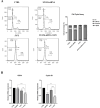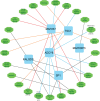Improvement of 5-fluorouracil chemosensitivity in colorectal cancer cells by siRNA-mediated silencing of STAT6 oncogene
- PMID: 38419894
- PMCID: PMC10897558
- DOI: 10.22038/IJBMS.2023.74275.16136
Improvement of 5-fluorouracil chemosensitivity in colorectal cancer cells by siRNA-mediated silencing of STAT6 oncogene
Abstract
Objectives: Colorectal cancer (CRC) remains a major health concern worldwide due to its high incidence, mortality rate, and resistance to conventional treatments. The discovery of new targets for cancer therapy is essential to improve the survival of CRC patients. Here, this study aims to present a finding that identifies the STAT6 oncogene as a potent therapeutic target for CRC.
Materials and methods: HT-29 CRC cells were transfected with STAT6 siRNA and treated with 5-fluorouracil (5-FU) alone and combined. Then, to evaluate cellular proliferation and apoptosis percentage, MTT assay and annexin V/PI staining were carried out, respectively. Moreover, the migration ability of HT-29 cells was followed using a wound-healing assay, and a colony formation assay was performed to explore cell stemness features. Gene expression was quantified via qRT-PCR. Afterward, functional enrichment analysis was used to learn in-depth about the STAT6 co-expressed genes and the pathways to which they belong.
Results: Our study shows that silencing STAT6 with small interfering RNA (siRNA) enhances the chemosensitivity of CRC cells to 5-FU, a commonly used chemotherapy drug, by inducing apoptosis, reducing proliferation, and inhibiting metastasis. These results suggest that combining 5-FU with STAT6-siRNA could provide a promising strategy for CRC treatment.
Conclusion: Our study sheds light on the potential of STAT6 as a druggable target for CRC cancers, the findings offer hope for more effective treatments for CRC patients, especially those with advanced stages that are resistant to conventional therapies.
Keywords: 5-Fluorouracil; Chemosensitivity; Colorectal cancer; STAT6; siRNA.
Conflict of interest statement
We certify that none of our associations or business interests poses a conflict of interest concerning the work that has been submitted.
Figures









Similar articles
-
CD44 Suppression Improved the Chemosensitivity of HT-29 Colorectal Cancer Cells to 5-Fluorouracil and Inhibited Cell Migration.Adv Pharm Bull. 2023 Jul;13(3):551-562. doi: 10.34172/apb.2023.053. Epub 2022 Jul 2. Adv Pharm Bull. 2023. PMID: 37646068 Free PMC article.
-
GDPD5, a target of miR-195-5p, is associated with metastasis and chemoresistance in colorectal cancer.Biomed Pharmacother. 2018 May;101:945-952. doi: 10.1016/j.biopha.2018.03.028. Epub 2018 Mar 22. Biomed Pharmacother. 2018. PMID: 29635904
-
Sanguisorba officinalis L. enhances the 5-fluorouracil sensitivity and overcomes chemoresistance in 5-fluorouracil-resistant colorectal cancer cells via Ras/MEK/ERK and PI3K/Akt pathways.Heliyon. 2023 Jun 3;9(6):e16798. doi: 10.1016/j.heliyon.2023.e16798. eCollection 2023 Jun. Heliyon. 2023. PMID: 37484409 Free PMC article.
-
Suppression of Nanog inhibited cell migration and increased the sensitivity of colorectal cancer cells to 5-fluorouracil.Eur J Pharmacol. 2021 Mar 5;894:173871. doi: 10.1016/j.ejphar.2021.173871. Epub 2021 Jan 16. Eur J Pharmacol. 2021. PMID: 33460610
-
Regulatory role of PPAR in colorectal cancer.Cell Death Discov. 2025 Jan 28;11(1):28. doi: 10.1038/s41420-025-02313-2. Cell Death Discov. 2025. PMID: 39875357 Free PMC article. Review.
References
-
- Siegel R, DeSantis C, Jemal A. Colorectal cancer statistics, 2014. CA Cancer j clin. 2014;64:104–117. - PubMed
LinkOut - more resources
Full Text Sources
Research Materials
Miscellaneous
